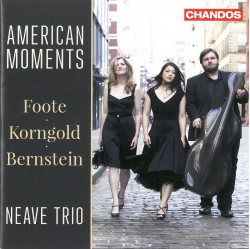 American Moments
American Moments
Neave Trio
Chandos CHAN 10924
“American” moments? Twelve-year-old wunderkind Erich Korngold was living in Vienna when he composed his Trio, Op.1 (1910), a well-constructed, exuberantly expressive piece already evincing some distinctive melodic turns that would reappear throughout his mature music. The Neave Trio seems to approach it from the perspective of those later works, with a sense of nostalgia rather than youthful ardour. (Korngold emigrated to the US in 1938.)
Leonard Bernstein’s Trio dates from 1937, when he was 19, studying at Harvard. Unpublished until after his death, it opens meditatively, leading to an extended Fugato and an exultant climax. The second movement anticipates the jazzy Bernstein, with pizzicato, blue notes and dancing syncopations. The finale begins with a questioning melody, answered by a rousing Jewish-klezmer romp. New to me, I quite enjoyed it.
Arthur Foote, in contrast, was 55 and well-established when he wrote his Piano Trio No.2 (1908). Considered the first significant composer trained entirely in the US, he, like most of his American contemporaries, still drew inspiration from European models. The first two movements, lilting, sweet and sentimental, are perfumes from a Viennese salon; the weightier finale evokes Foote’s much-beloved Brahms.
America, like Canada, is a nation of immigrants, making the Neave Trio, currently visiting artists at Brown University, truly American, with its violinist from the US, cellist from Russia and pianist from Japan. Their performances of these stylistically varied works amount to a concert program for home listening that’s highly entertaining.



